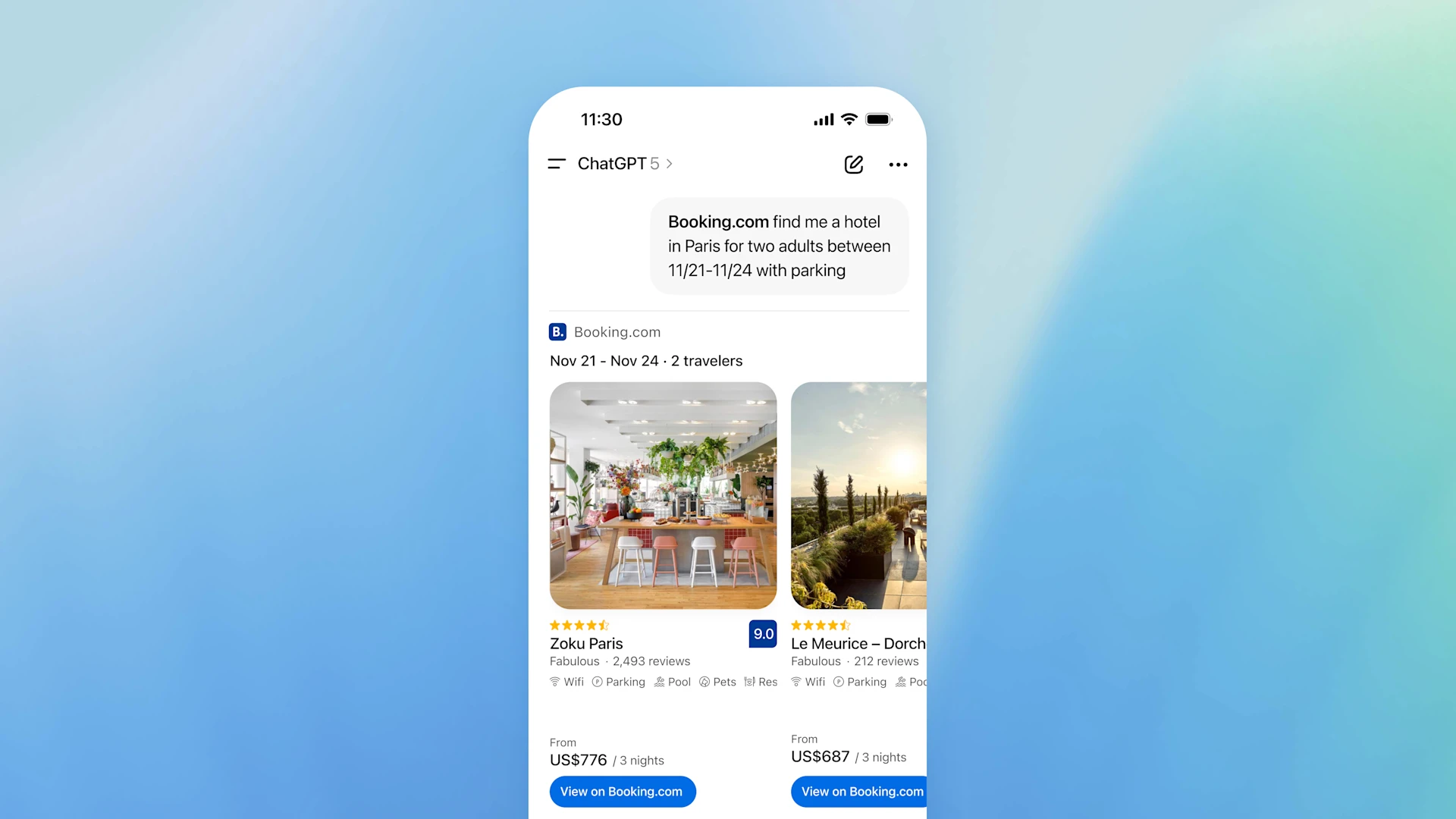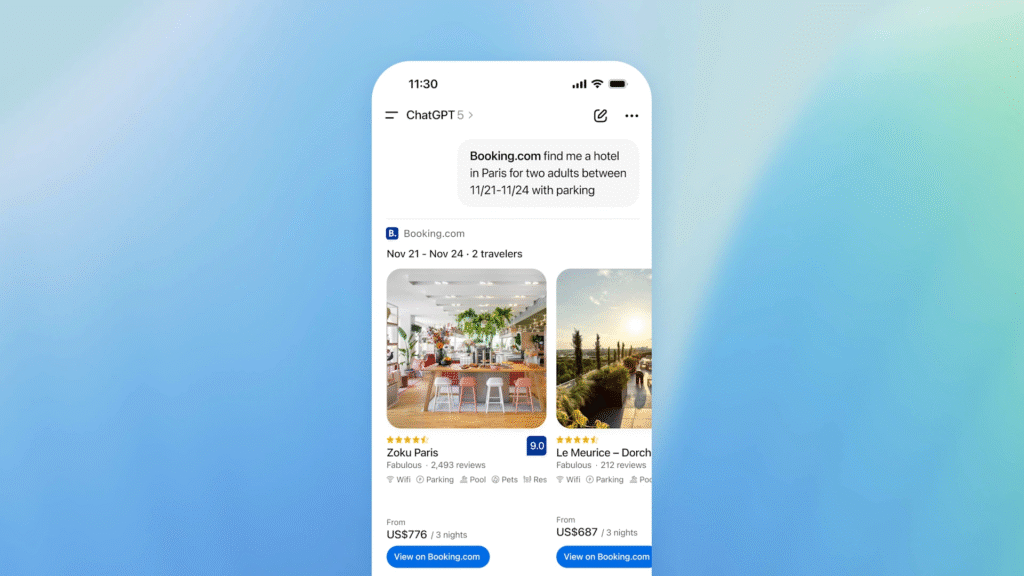
OpenAI's annual conference for third-party developers, DevDay, kicked off with a bang today as co-founder and CEO Sam Altman announced a new "Apps SDK" that makes it "possible to build apps inside of ChatGPT," including paid apps, which companies can charge users for using OpenAI's recently unveiled Agentic Commerce Protocol (ACP).
In other words, instead of launching apps one-by-one on your phone, computer, or on the web — now you can do all that without ever leaving ChatGPT.
This feature allows the user to log-into their accounts on those external apps and bring all their information back into ChatGPT, and use the apps very similarly to how they already do outside of the chatbot, but now with the ability to ask ChatGPT to perform certain actions, analyze content, or go beyond what each app could offer on its own.
You can direct Canva to make you slides based on a text description, ask Zillow for home listings in a certain area fitting certain requirements, or as Coursera about a specific lesson's content while it plays on video, all from within ChatGPT — with many other apps also already offering their-own connections (see below).
"This will enable a new generation of apps that are interactive, adaptive and personalized, that you can chat with," Altman said.
While the Apps SDK is available today in preview, OpenAI said it would not begin accepting new apps within ChatGPT or allow them to charge users until "later this year."
Built atop common MCP standard
Built on the open source standard Model Context Protocol (MCP) introduced by rival Anthropic nearly a year ago, the Apps SDK gives third-party developers working independently or on behalf of enterprises large and small to connect selected data, "trigger actions, and render a fully interactive UI [user interface]" Altman explained during his introductory keynote speech.
The Apps SDK includes a "talking to apps" feature that allows ChatGPT and the underlying GPT-5 or other "o-series" models piloting it underneath to obtain updated context from the third-party app or service, so the model "always knows about exactly what you're user is interacting with," according to another presenter and OpenAI engineer, Alexi Christakis.
Developers can build apps that:
appear inline in chat as lightweight cards or carousels
expand to fullscreen for immersive tasks like maps, menus, or slides
use picture-in-picture for live sessions such as video, games, or quizzes
Each mode is designed to preserve ChatGPT’s minimal, conversational flow while adding interactivity and brand presence.
Early integrations with Coursera, Canva, Zillow and more…
Christakis showed off early integrations of external apps built atop the Apps SDK, including ones from e-learning company Coursera, cloud design software company Canva, and real estate listings and agent connections search engine, Zillow.
Altman also announced Apps SDK integrations with additional partners not demoed officially during the keynote including: Booking.com, Expedia, Figma and Spotify and in documentation, said more upcoming partners are on deck: AllTrails, Peloton, OpenTable, Target, theFork, and Uber, representing lifestyle, commerce, and productivity categories.
The Coursera demo included an example of how the user onboards to the external app, including a new login screen for the app (Coursera) that appears within the ChatGPT chat interface, activated simply by a text prompt from the user asking: "Coursera can you teach me something about machine learning"?
Once logged in, the app launched within the chat interface, "in line" and can render anything from the web, including interactive elements like video.
Christakis explained and showed the Apps SDK also supports "picture-in-picture" and "fullscreen" views, allowing the user to choose how to interact with it.
When playing a Coursera video that appeared, he showed that it automatically pinned the video to the top of the screen so the user could keep watching it even as they continued to have a back-and-forth dialog in text with ChatGPT in the typical input/output prompts and responses below.
Users can then ask ChatGPT about content appearing in the video without specifying exactly what was said, as the Agents SDK pipes the information on the backend, server-side, from the connected app to the underlying ChatGPT AI model. So "can you explain more about what they're saying right now" will automatically surface the relevant portion of the video and provide that to the underlying AI model for it to analyze and respond to through text.
In another example, Christakis opened an older, existing ChatGPT conversation he'd had about his siblings' dog walking business and resumed the conversation by asking another third-party app, Canva, to generate a poster using one of ChatGPT's recommended business names, "Walk This Wag," along with specific guidance about font choice ("sans serif") and overall coloration and style ("bright and colorful.")
Instead of the user manually having to go and add all those specific elements to a Canva template, ChatGPT went and issued the commands and performed the actions on behalf of the user in the background.
After a few minutes, ChatGPT responded with several poster designs generated directly within the Canva app, but displayed them all in the user's ChatGPT chat session where they could see, review, enlarge and provide feedback or ask for adjustments on all of them.
Christakis then asked for ChatGPT to turn one of the slides into an entire slide deck so the founders of the dog walking business could present it to investors, which did it in the background over several minutes while he presented a final integrated app, Zillow.
He started a new chat session and asked a simple question: "based on our conversations, what would be a good city to expand the dog walking business."
Using ChatGPT's optional memory feature, it referenced the dog walk conversation and suggested Pittsburgh, which Christakis used as a chance to type in "Zillow" and "show me some homes for sale there," which called up an interactive map from Zillow with homes for sale and prices listed and hover-over animations, all in-line within ChatGPT.
Clicking a specific home also opened a fullscreen view with "most of the Zillow experience," entirely without leaving ChatGPT, including the ability to request home tours and contact agents and filtering by bedrooms and other qualities like outdoor space. ChatGPT pulls up the requested filtered Zillow search as well as provides a text-based response in-line explaining what it did and why.
The user can then ask follow-up questions about the specific property — such as "how close is it to a dog park?" — or compare it to other properties, all within ChatGPT.
It can also use apps in conjunction with its Search function, searching the web to compare the app information (in this case, Zillow) with other sources.
Safety, privacy, and developer standards
OpenAI emphasized that apps must comply with strict privacy, safety, and content standards to be listed in the ChatGPT directory. Apps must:
serve a clear and valuable purpose
be predictable and reliable in behavior
be safe for general audiences, including teens aged 13–17
respect user privacy and limit data collection to only what’s necessary
Every app must also include a clear, published privacy policy, obtain user consent before connecting, and identify any actions that modify external data (e.g., posting, sending, uploading).
Apps violating OpenAI’s usage policies, crashing frequently, or misrepresenting their capabilities may be removed at any time. Developers must submit from verified accounts, provide customer support contacts, and maintain their apps for stability and compliance.
OpenAI also published developer design guidelines, outlining how apps should look, sound, and behave. They must follow ChatGPT’s visual system — including consistent color palettes, typography, spacing, and iconography — and maintain accessibility standards such as alt text and readable contrast ratios.
Partners can show brand logos and accent colors but not alter ChatGPT’s core interface or use promotional language. Apps should remain “conversational, intelligent, simple, responsive, and accessible,” according to the documentation.
A new conversational app ecosystem
By opening ChatGPT to third-party apps and payments, OpenAI is taking a major step toward transforming ChatGPT from a chatbot into a full-fledged AI operating system — one that combines conversational intelligence, rich interfaces, and embedded commerce.
For developers, that means direct access to over 800 million ChatGPT users, who can discover apps “at the right time” through natural conversation — whether planning trips, learning, or shopping.
For users, it means a new generation of apps you can chat with — where a single interface helps you book a flight, design a slide deck, or learn a new skill without ever leaving ChatGPT.
As OpenAI put it: “This is just the start of apps in ChatGPT, bringing new utility to users and new opportunities for developers.”
There remain a few big questions, namely: 1. what happens to all the data from those third-party apps as they interface with ChatGPT and its users…does OpenAI get access to it and can it train upon it? 2. What happens to OpenAI's once much-hyped GPT Store, which had been in the past promoted as a way for third-party creators and developers to create custom, task-specific versions of ChatGPT and make money on them through a usage-based revenue share model?
We've asked the company about both issues and will update when we hear back.

